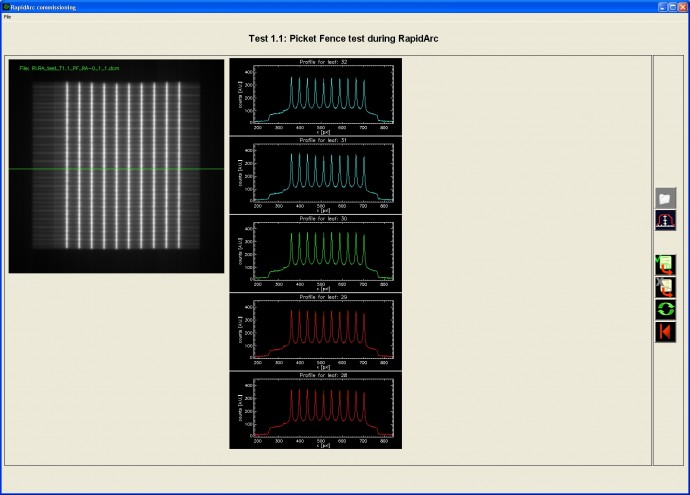RapidArc machine QA
Commissioning and QA procedures of RapidArc must address the reliability and accuracy of these parameters: variable dose-rate, variable gantry speed, and dynamic MLC during gantry rotation.
Artemis offers a dedicated analysis tool which allows the user to verify Clinac performance with tests based on the official Varian tests for RapidArc commissioning and QA as described in Ling CC, et. al: Commissioning and Quality Assurance of RapidArc Radiotherapy Delivery System
-
test MLC positional accuracy
-
assess the accuracy of variable dose-rate
-
evaluate the accuracy of MLC leaf speed
The tests are grouped in prerequisite tests and RapidArc specific commissioning tests. The tests numbers and names relate to the mentioned document.
Prerequisite tests include picket fence test at multiple gantry angles and output measurement for a 4 cm x 10 cm field with a 0.5 cm DMLC slit at different gantry angles to assess the effect of gravity on the MLC carriage.
RapidArc commissioning test include the three most important elements: accuracy in DMLC position and precise dose-rate control during gantry rotation, and accurate control of gantry speed. In RapidArc delivery, the Clinac executes processes that implement the appropriate gantry speed, dose-rate and MLC motion so as to comply with the parameters specified in the RapidArc treatment plan. Thus one needs to assess the performance of the machine in all these areas.
Test 1: Accuracy of DMLC position during RapidArc
To assess the accuracy of DMLC leaf positions, Epiqa use for Rapid Arc the picket fence test, for comparison with the same pattern acquired with static gantry. Similar test with intentional changes in positions and widths of the picket-fence is introduced to demonstrate the sensitivity of the test. This test indicate that any increase in MLC uncertainty is much less than 0.5 mm, and that this test is sensitive enough to detect errors of 0.5 mm. Epiqa allows visual and qualitative analysis of the performance of each leaf pair separately.
Artemis manages the profiles across the acquired image. Green profile corresponds to the green line position in the left window, two previous leave profiles are displayed in cyan and two next ones in red colour.
Test 2: Accurate control of Dose Rate and Gantry Speed during RapidArc delivery
In this test Epiqa evaluate the ability of the Clinac to modulate dose rate and gantry speed to achieve the specified values. This test uses seven combinations of dose-rate, gantry range and gantry speed to give equal dose to seven 1.8 cm wide strips in a single RapidArc field. Epiqa calculate the deviation from the reference value, defined as average value of all the ROI´s and recommended tolerance is ± 2%.
Test 3: Accurate control of Leaf Speed during RapidArc delivery
Having validated MLC accuracy and the Clinac’s ability to vary dose-rate and gantry speed in the previous tests, you can evaluate the MLC leaf-speed control during RapidArc. Results of this tests are influenced by correct performance of MLC motions but also by gantry speed and correct dose rate.
This test uses four combinations of leaf speed and dose-rate to give equal dose to four strips in a single RapidArc field. Epiqa calculate the deviation from the reference value, defined as average value of all the ROI´s and recommended tolerance is ± 2%.
The RapidArc commissioning and QA program will test and ensure reliable system capabilities that are incremental to those of IMRT-DMLC. All your results and comments can be stored in a report.
Last update on 06. January 2011







